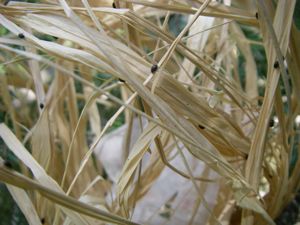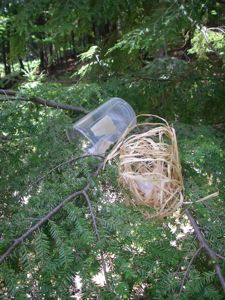Seeing the Forest for its Bugs
Air Date: Week of July 9, 2010

The adelgid-eating predatory beetles crawl on the straw they were shipped with. (Photo: Emily Guerin)
The hemlock wooly adelgid is eating its way up the East Coast's hemlock forests. Now researchers are fighting back with tiny beetles. Emily Guerin joined an entomologist in York, Maine to see how the forest is faring.
Transcript
YOUNG: A tiny insect is literally sucking the life out of hemlock trees in the Eastern United States. The hemlock wooly adelgid was first spotted in Virginia in the 1950s. Since then it’s hit roughly half the hemlocks from Georgia to Massachusetts. Some beloved old groves, likes those that shaded streams of Shenandoah National Park, are gone. Now the little adelgid is headed north. Emily Guerin tagged along with an entomologist in York, Maine, to see how scientists in the nation’s most forested state are trying to keep the bug at bay.
[BIRDS SINGING, WIND IN TREES]
GUERIN: Allison Kanoti is pacing up and down the banks of a wooded stream. She stops in front of a hemlock tree, rolls up the sleeves of her oversized Forest Service uniform and runs her hands over the branches, squinting in the bright sun.
[BRANCHES RUSTLING]
KANOTI: It’s important to look on the undersides of the branches, because when hemlock wooly adelgid populations are low, the infestations aren’t going to be very visible from above.

Allison Kanoti stands on a bridge at the York Water district after releasing predatory beetles. (Photo: Emily Guerin)
GUERIN: Kanoti is on the front lines of the battle against the hemlock wooly adelgid. The pest feeds on the tree’s needles, buds and twigs and is an efficient killer—infested trees don’t last much longer than four years.
KANOTI: This hemlock is in really good health, you can see it has a lot of new growth on it and it’s actually still pretty vigorous, and it actually has pretty low adelgid populations. The next tree you’ll see over there actually its in pretty poor health and has a really high adelgid population.
[FOOTSTEPS CRUNCHING ON GRASS]
GUERIN: Kanoti points to a tree she describes as one of the worst looking in the state. Some branches have bare spots and its needles are dry and brittle. She turns the branches over, looking for the insect’s trademark cottony masses. But there are other ways to tell if a tree is infested.
KANOTI: What you’ll notice…is a general lack of new growth…because of that you get pre-mature needle drop so needles will actually fall off and that’s why the crown looks thinner, cause it’s losing those old needles that would normally hold on for 3 years, it’s losing them more quickly…

A nifty bumper sticker on a Maine Forest Service vehicle. (Photo: Emily Guerin)
GUERIN: The wooly adelgid is already threatening a southeastern species with extinction, the Carolina hemlock. But Kanoti and other Maine Forest Service entomologists aren’t standing by while the adelgid eats its way through the state. Instead, they’re using bio-control to keep it in check. Essentially, they’re fighting bugs with bugs.
[TAPE BEING RIPPED OFF A BOX]
GUERIN: Kanoti rips open a box packed with plastic deli containers and crumpled newspaper. Each container is stuffed with dry straw and crawling with five hundred dollars worth of black beetles—at over $2 a piece, they’re pricey little insects. But they feed vigorously on adelgid, their only known prey. Kanoti reaches for a container and peels off the lid, shaking the contents out onto a branch.
[LID BEING PEELED BACK, PAPER RUSTLING]
KANOTI: And they should be ready to feed when we release them. And they’re going to fly around quite a bit, so you may have them land on your and go up your nose and that sort of stuff, so, just a warning…
GUERIN: They’re really small, a lot smaller than I thought, they’re like, almost the size of, you know, a couple of periods on the end of a sentence.
KANOTI: Yeah they’re tiny. They’re just a couple of millimeters maybe, it really makes sense because their prey is also very small.
GUERIN: The Forest Service believes these little beetles are the hemlock’s best hope for combating the wooly adelgid. If the adelgid wins, it’s not only the hemlocks that lose. The trees play an important, irreplaceable role in their ecosystem, especially along streams.
KANOTI: Hemlocks shading the stream actually influence the water temperature, influence survival of some macroinvertibrates living in the stream, and on very small streams, headwater streams, they can extend the seasonality of those streams, so they’re much more important than may be initially apparent, I guess.
GUERIN: Pesticides are more effective against the adelgid but scientists try to avoid using them near streams. And even though the predator beetles are adept adelgid eaters, entomologists know that it’s impossible to eliminate the invasive insect. Allison Kanoti says that’s not their goal.

The bug-covered straw is dumped out on a branch of a hemlock tree. (Photo: Emily Guerin)
KANOTI: With these predators we aren’t trying to eradicate the hemlock wooly adelgid, that’s not really possible anyway, we’re just trying to bring their populations below damaging levels.
GUERIN: While Kanoti and other entomologists work on killing adelgid, lawmakers in Maine are also trying to slow down the insect’s spread. The adelgids move slowly by themselves, but can hitch a ride in firewood. And since Maine is a popular camping destination, the risk is high. So a new law makes it illegal to bring firewood into the state. But Kanoti says, humans inadvertently aid adelgids in other ways. Climate change is a major boost to the insects.
KANOTI: I mean, an example of what a warm winter does, this year we only had about 17% mortality on average across the sites we sampled for over-wintering mortality. I’ve only been doing this for four years but in those four years that is more than half as low as any of the other lower readings I’ve had…and we really want to see over 90% mortality in order to see, sort of, a stable population of adelgid as opposed to an expanding population of adelgid.

The adelgid-eating predatory beetles crawl on the straw they were shipped with. (Photo: Emily Guerin)
GUERIN: The odds are certainly stacked in the adelgid’s favor. Entomologists like Kanoti aren’t even sure how effective bio-control is. It takes multiple releases over many years for the beetles to become established enough to make a dent in the adelgid population. And by then, the adelgid may have moved elsewhere.
But there are some signs of progress. The predator beetles seem to be settling in and are spreading to other infected hemlocks. And Kanoti is releasing more beetles whenever she can get a hold of them, usually about once a year.
KANOTI: Bio-control is a real long-term commitment, really. We’re investing for the long term here. We don’t expect magic results overnight.
GUERIN: Or even within a couple of years. But the hope is that the firewood ban and the beetles will slow the adelgid down, giving foresters time to come up with better ideas to combat the infestation.
For Living on Earth, I’m Emily Guerin in York, Maine.
[MUSIC] Andrei Krylov “Beetles learning Yoga In India” from Dragon From The Dark Side Of The Moon Freakout (Andrei Krylov Music 2010).
Links
Living on Earth wants to hear from you!
Living on Earth
62 Calef Highway, Suite 212
Lee, NH 03861
Telephone: 617-287-4121
E-mail: comments@loe.org
Newsletter [Click here]
Donate to Living on Earth!
Living on Earth is an independent media program and relies entirely on contributions from listeners and institutions supporting public service. Please donate now to preserve an independent environmental voice.
NewsletterLiving on Earth offers a weekly delivery of the show's rundown to your mailbox. Sign up for our newsletter today!
 Sailors For The Sea: Be the change you want to sea.
Sailors For The Sea: Be the change you want to sea.
 The Grantham Foundation for the Protection of the Environment: Committed to protecting and improving the health of the global environment.
The Grantham Foundation for the Protection of the Environment: Committed to protecting and improving the health of the global environment.
 Contribute to Living on Earth and receive, as our gift to you, an archival print of one of Mark Seth Lender's extraordinary wildlife photographs. Follow the link to see Mark's current collection of photographs.
Contribute to Living on Earth and receive, as our gift to you, an archival print of one of Mark Seth Lender's extraordinary wildlife photographs. Follow the link to see Mark's current collection of photographs.
 Buy a signed copy of Mark Seth Lender's book Smeagull the Seagull & support Living on Earth
Buy a signed copy of Mark Seth Lender's book Smeagull the Seagull & support Living on Earth

